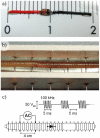Remote electrical stimulation by means of implanted rectifiers
- PMID: 21850274
- PMCID: PMC3151300
- DOI: 10.1371/journal.pone.0023456
Remote electrical stimulation by means of implanted rectifiers
Abstract
Miniaturization of active implantable medical devices is currently compromised by the available means for electrically powering them. Most common energy supply techniques for implants--batteries and inductive couplers--comprise bulky parts which, in most cases, are significantly larger than the circuitry they feed. Here, for overcoming such miniaturization bottleneck in the case of implants for electrical stimulation, it is proposed to make those implants act as rectifiers of high frequency bursts supplied by remote electrodes. In this way, low frequency currents will be generated locally around the implant and these low frequency currents will perform stimulation of excitable tissues whereas the high frequency currents will cause only innocuous heating. The present study numerically demonstrates that low frequency currents capable of stimulation can be produced by a miniature device behaving as a diode when high frequency currents, neither capable of thermal damage nor of stimulation, flow through the tissue where the device is implanted. Moreover, experimental evidence is provided by an in vivo proof of concept model consisting of an anesthetized earthworm in which a commercial diode was implanted. With currently available microelectronic techniques, very thin stimulation capsules (diameter <500 µm) deliverable by injection are easily conceivable.
Conflict of interest statement
Figures




Similar articles
-
In Vivo Demonstration of Addressable Microstimulators Powered by Rectification of Epidermically Applied Currents for Miniaturized Neuroprostheses.PLoS One. 2015 Jul 6;10(7):e0131666. doi: 10.1371/journal.pone.0131666. eCollection 2015. PLoS One. 2015. PMID: 26147771 Free PMC article.
-
Towards addressable wireless microstimulators based on electronic rectification of epidermically applied currents.Annu Int Conf IEEE Eng Med Biol Soc. 2014;2014:3973-6. doi: 10.1109/EMBC.2014.6944494. Annu Int Conf IEEE Eng Med Biol Soc. 2014. PMID: 25570862
-
In vivo demonstration of injectable microstimulators based on charge-balanced rectification of epidermically applied currents.J Neural Eng. 2015 Dec;12(6):066010. doi: 10.1088/1741-2560/12/6/066010. Epub 2015 Oct 8. J Neural Eng. 2015. PMID: 26447945
-
[Review of the design of power supply in retinal implants].Sheng Wu Yi Xue Gong Cheng Xue Za Zhi. 2008 Aug;25(4):954-7. Sheng Wu Yi Xue Gong Cheng Xue Za Zhi. 2008. PMID: 18788317 Review. Chinese.
-
A new approach towards a minimal invasive retina implant.J Neural Eng. 2007 Mar;4(1):S30-7. doi: 10.1088/1741-2560/4/1/S05. Epub 2007 Feb 20. J Neural Eng. 2007. PMID: 17325414 Review.
Cited by
-
First-in-human demonstration of floating EMG sensors and stimulators wirelessly powered and operated by volume conduction.J Neuroeng Rehabil. 2024 Jan 3;21(1):4. doi: 10.1186/s12984-023-01295-5. J Neuroeng Rehabil. 2024. PMID: 38172975 Free PMC article.
-
In Vivo Demonstration of Addressable Microstimulators Powered by Rectification of Epidermically Applied Currents for Miniaturized Neuroprostheses.PLoS One. 2015 Jul 6;10(7):e0131666. doi: 10.1371/journal.pone.0131666. eCollection 2015. PLoS One. 2015. PMID: 26147771 Free PMC article.
References
-
- Olivo J, Carrara S, De Micheli G. Energy harvesting and remote powering for implantable biosensors. Sensors Journal, IEEE. 2011;11(7):1573–1586.
-
- Loeb GE, Zamin CJ, Schulman JH, Troyk PR. Injectable microstimulator for functional electrical stimulation. Med Biol Eng Comput. 1991;29(6):NS13–9. - PubMed
-
- Kane MJ, Breen PP, Quondamatteo F, OLaighin G. BION microstimulators: A case study in the engineering of an electronic implantable medical device. Med Eng Phys. 2011;33(1):7–16. - PubMed
-
- Schuder JC, Stephenson HE. Energy transport to a coil which circumscribes a ferrite core and is implanted within the body. Biomedical Engineering, IEEE Transactions on BME- 1965;12(3):154–163. - PubMed
-
- Heetderks WJ. RF powering of millimeter- and submillimeter-sized neural prosthetic implants. Biomedical Engineering, IEEE Transactions on. 1988;35(5):323–327. - PubMed
Publication types
MeSH terms
LinkOut - more resources
Full Text Sources

